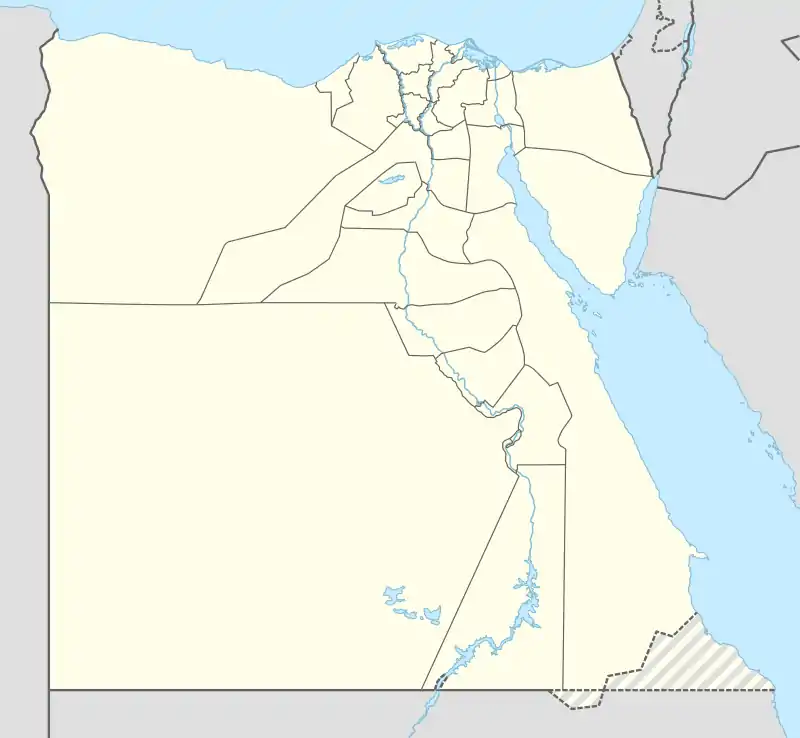 Shown within Egypt | |
| Location | near Saint Catherine's Monastery, Egypt |
|---|---|
| Region | Sinai |
| Coordinates | 28°33′20″N 33°58′34″E / 28.5555°N 33.9762°E |
| Type | Cluster of Tells |
| Part of | Settlements |
| Length | 20 metres (66 ft) (Abu Madi III) |
| Width | 20 metres (66 ft) (Abu Madi III) |
| Area | 0.008 hectares (860 sq ft) (Abu Madi I) |
| History | |
| Material | Granite |
| Founded | c. 10100 BP |
| Abandoned | c. 9700 BP |
| Periods | Khiamian, PPNA |
| Cultures | Khiamian, Abu Madi Entity |
| Site notes | |
| Excavation dates | 1980– |
| Archaeologists | Ofer Bar-Yosef |
| Condition | Ruins |
| Public access | Yes |
Abu Madi (Arabic:أبو ماضي) is a cluster of prehistoric, Neolithic tell mounds in Southern Sinai, Egypt. It is located east of Saint Catherine's Monastery at the bottom of a granite ridge. It was suggested to have been a seasonal encampment for groups of hunter gatherers and contained the remains of two major settlements; Abu Madi I and Abu Madi III.[1][2] Abi Madi I is a small site with the remains of a partially buried 4 metres (13 ft) building containing deposits up to a depth of 1.3 metres (4.3 ft).[3] Abu Madi III was an area of roughly 20 square metres (220 sq ft) that was excavated close to a large nearby boulder.[4] Dwellings were found to have stone built silos next to them.[5] It was first excavated in the early 1980s by Ofer Bar-Yosef.[6]
Culture
The culture has been referred to as the Abu Madi Entity as it shows evidence of having retained Natufian characteristics of a temporary settlement, while being at least partly contemporary with the PPNA cultures of the Levant further to the North. It has been dated approximately 10100 to 9700 BP[7] or from between 9660 to 9180 BC[8] with calibrated datings ranging between c. 9750 and 7760 BC.[9] Judging by these radiocarbon dates, Abu Madi has been suggested to be a form of late Khiamian culture.[10] It has been suggested that the dwellings found housed small groups of nuclear families continuing in the Natufian style.[11] A large number of chipped flints were recovered including a new type of aerodynamic arrowhead known as the Abu Madi Point characterised by elongated ovals or rhomboid shapes, occasionally with a small tang.[1] El Khiam points were also found with deep concave bases[12] and it has been suggested these arrowheads were used to hunt such animals as gazelles and wild ibexes.[13] Abu Madi has been suggested to be amongst the ten probable centers for the origin of agriculture and used in statistical analysis to determine the rate of spread into Europe.[14]
Literature
- Bar-Yosef, Ofer., Neolithic Sites in Sinai, Frey and Uerpmann 1981, Beiträge zur Umweltgeschichte des Vorderen Orients, Tübinger Atlas des Vorderen Orients (TAVO) A 8, Wiesbaden, pp. 217–235, 19 pages, 1981.
- Gopher, Avi., Flint tool industries of the Neolithic period in Israel, PhD thesis, Hebrew University Jerusalem, 389 pages, 1985.
- Kuijt, I. Bar-Yosef, O., Radiocarbon Chronology for the Levantine Neolithic: Observations and Data, Radiocarbon, 36, 227–245, 1994.
- Gopher, A., Arrowheads of the Neolithic Levant. A Seriation Analysis, PhD thesis. American Schools of Oriental Research. Dissertation Series 10, 1994.
References
- 1 2 Ofer Bar-Yosef; Eitan Tchernov; Avi Gopher (1997). An early neolithic village in the Jordan Valley. Peabody Museum of Archaeology and Ethnology, Harvard University. ISBN 978-0-87365-547-7.
- ↑ Fredrik Talmage Hiebert (1994). Origins of the Bronze Age oasis civilization in Central Asia. Peabody Museum of Archaeology and Ethnology, Harvard University. ISBN 978-0-87365-545-3.
- ↑ The Review of archaeology. Review of Archaeology. 1991.
- ↑ Juliet Clutton-Brock; Caroline Grigson; International Council for Archaeozoology; University of London. Institute of Archaeology (1984). Animals and Archaeology: Early herders and their flocks. British Archaeological Reports. ISBN 978-0-86054-259-9.
- ↑ Pavel Markovich Dolukhanov (1994). Environment and ethnicty [sic] in the Middle East. Avebury. ISBN 978-1-85628-706-7.
- ↑ Bar-Yosef, Ofer., Pre-Pottery Neolithic sites in Southern Sinai. Biblical Archaeologist 45:9–12, 1981.
- ↑ Ian Kuijt (2000). Life in Neolithic farming communities: social organization, identity, and differentiation. Springer. p. 33. ISBN 978-0-306-46122-4.
- ↑ Forster, ex oriente e.V. & Marion Benz & datalino, Christoph. "exoriente e.V. - PPND (neolithic radiocarbon dates) - Site". www.exoriente.org. Retrieved 26 February 2018.
{{cite web}}: CS1 maint: multiple names: authors list (link) - ↑ ITmatters.de, Steffen Steiner -. "radiocarbon CONTEXT database". context-database.uni-koeln.de. Retrieved 26 February 2018.
- ↑ Jacques Cauvin; Trevor Watkins (2000). The birth of the Gods and the origins of agriculture. Cambridge University Press. p. 222. ISBN 978-0-521-65135-6.
- ↑ Jean-Pierre Bocquet-Appel; Ofer Bar-Yosef (2008). The Neolithic Demographic Transition and Its Consequences. Springer. p. 274. ISBN 978-1-4020-8538-3.
- ↑ Gopher Avi. , Bar-Yosef Ofer. , Nadel D., Early Neolithic arrowhead types in the Southern Levant : a typological suggestion, Paléorient, Volume 17, Number 17-1, pp. 109–11, 1991.
- ↑ British School of Archaeology in Jerusalem (2001). Levant.
- ↑ Pinhasi R, Fort J, Ammerman AJ., Tracing the Origin and Spread of Agriculture in Europe. PLoS Biol 3(12): e410. (2005) doi:10.1371/journal.pbio.0030410